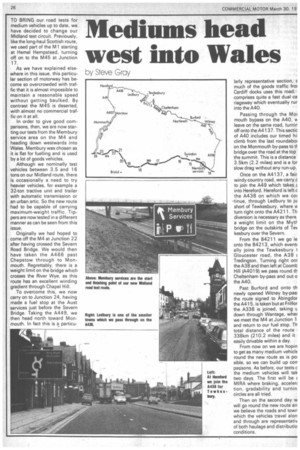Mediums head west into Wales
Page 28

If you've noticed an error in this article please click here to report it so we can fix it.
by Steve Gray
TO BRING our road tests for medium vehicles up to date, we have decided to change our Midland test circuit. Previously, like the long-haul Scottish route, we used part of the M1 starting at Hemel Hempstead, turning off on to the M45 at Junction 17.
As we have explained elsewhere in this issue, this particu
lar section of motorway has be come so overcrowded with traffic that it is almost impossible to
maintain a reasonable speed without getting baulked. By contrast the M45 is deserted, with almost no commercial traffic on it at all.
In order to give good comparisons, then, we are now star ting our tests from the Membury service area on the M4 and heading down westwards into Wales. Membury was chosen as it is flat for fuelling and is used by a lot of goods vehicles.
Although we nominally test vehicles between 3.5 and 16 tons on our Midland route, there is occasionally a need to try heavier vehicles, for example a 32-ton tractive unit and trailer with automatic transmission or an urban artic. So the new route had to be capable of carrying maximum-weight traffic. Tippers are now tested in a different manner as can be seen from this issue.
Originally we had hoped to come off the M4 at Junction 22
after having crossed the Severn Road Bridge. We would then have taken the A466 past Chepstow through to Mon mouth. Regrettably, there is a weight limit on the bridge which crosses the River Wye, as this route has an excellent winding gradient through Chapel Hill.
To overcome this, we now carry on to Junction 24, having made a fuel stop at the Aust services just before the Severn Bridge. Taking the A449, we then head north toward Monmouth. In fact this is a particu
larly representative section, E much of the goods traffic fror Cardiff docks uses this road. comprises quite a fast dual ca riageway which eventually rur into the A40.
Passing through the Mol mouth bypass on the A40, v■ leave on the same road, turnin off onto the A4137. This sectic of A40 includes our timed hil climb from the last roundaboi on the Monmouth by-pass to tl• bridge over the road at the top the summit. This is a distance 3.5km (2.2 miles) and is a or slow drag without any run-up.
Once on the A4137, a fair windy country road, we carry c to join the A49 which takes t into Hereford. Hereford is left c the A438 on which we col -tinue, through Ledbury to ju short of Tewkesbury, where In turn right onto the A4211. Th diversion is necessary as there a weight limit on the Myth bridge on the outskirts of Tev kesbury over the Severn.
From the B4211 we go le onto the B4213, which event' ally joins the Tewkesbury t Gloucester road, the A38 t Tredington. Turning right ant the A38 and then left at Coomb Hill (A4019) we pass round th Cheltenham by-pass and out o the A40.
Past Burford and onto th newly opened Witney by-pas! the route signed to Abingdor the A415, is taken but at Frilfor the A338 is joined, taking L down through Wantage, wher we meet the M4 at Junction 1 and return to our fuel stop. Th total distance of the route I 338km (210.2 miles) and it easily drivable within a day.
From now on we are hopin to get as many medium vehicIE round the new route as is poi sible, so we can build up con pacisons. As before, our tests c the medium vehicles will tak two days. The first will be 2 MIRA where braking, accelerr tion, gradability and turnin circles are all tried.
Then on the second day w will go round the new route an we believe the roads and town which the vehicles travel alon and through are representativ of both haulage and distributio conditions.
























































































